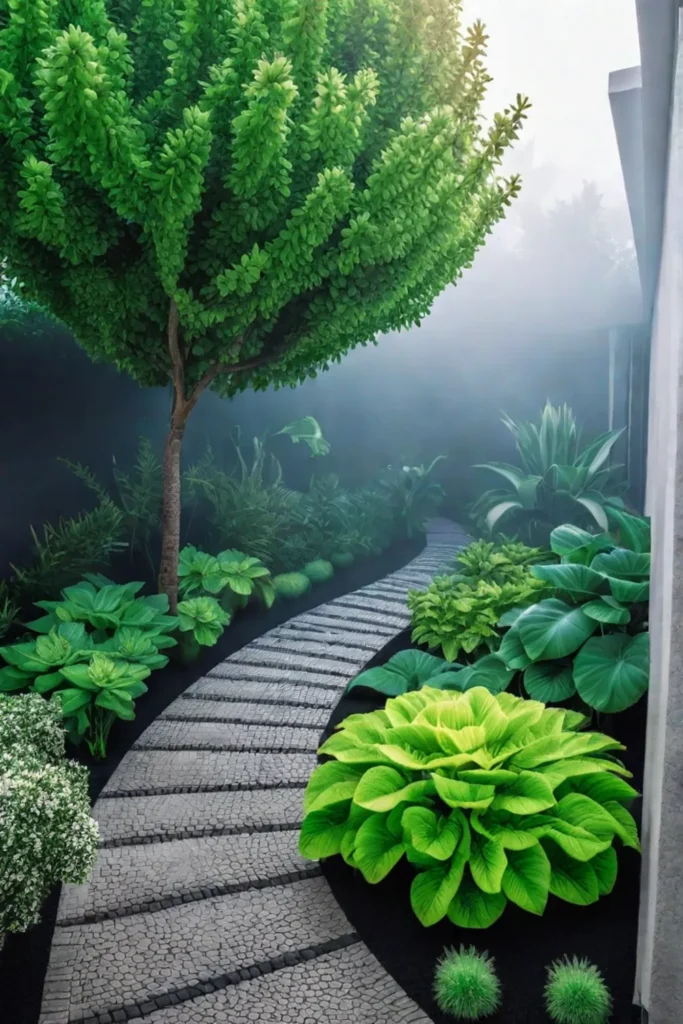As someone deeply passionate about sustainable living, I often dream of an outdoor oasis that celebrates the beauty of nature while treading lightly on the earth. Imagine a backyard where lush, drought-tolerant plants thrive, rainwater is harvested and cherished, and every element harmoniously reflects our commitment to the environment. This is the vision I invite you to explore—a transformative journey that will guide you in creating an eco-friendly backyard paradise right in your own backyard.
From embracing native plants that conserve precious water resources to harnessing the power of rainwater and composting, we’ll uncover practical strategies that nurture our gardens and nourish the planet. Together, we’ll delve into permaculture principles, a holistic approach that celebrates the interconnectedness of all living things, and discover creative alternatives to traditional, resource-intensive lawns.

But our journey doesn’t stop there. We’ll explore the world of natural pest control, where beneficial insects and companion planting become our allies in maintaining a thriving, chemical-free garden. And finally, we’ll uncover the secrets to incorporating sustainable materials into our landscaping projects, ensuring that every element of our backyard oasis is a testament to our commitment to mindful living.
So, join me as we embark on this transformative path, where every step brings us closer to a harmonious union between our outdoor spaces and the natural world. It’s time to create a backyard that nourishes our souls and nurtures the planet we call home.
Embrace Drought-Tolerant Plants
What if I told you that you could transform your thirsty, high-maintenance lawn into a lush, vibrant oasis that conserves water and supports local biodiversity? Embracing drought-tolerant plants is the key to unlocking a sustainable, low-maintenance backyard paradise that perfectly complements Boulder’s arid climate and eco-conscious lifestyle.

Selecting the Right Plants for Your Region
The first step in creating a drought-tolerant landscape is understanding your region’s unique climate and soil conditions. Here in Boulder, we’re blessed with abundant native plants that have adapted to thrive in our semi-arid environment over centuries. By incorporating these resilient species into your landscaping, you’ll reduce your water consumption and provide vital habitat for local wildlife.
Creating a Diverse and Thriving Ecosystem
Diversity is the cornerstone of a healthy, drought-tolerant garden. By combining a variety of plants with different water needs, bloom times, and growth habits, you’ll create a visually stunning tapestry that supports a thriving ecosystem. Imagine swaths of vibrant succulents mingling with fragrant lavender, interspersed with the delicate blooms of drought-resistant wildflowers like yarrow and blanket flowers.
Practical Tips for a Low-Maintenance Oasis
To maximize the benefits of your drought-tolerant landscape, group plants with similar water needs together and mulch generously to retain precious soil moisture. Consider incorporating hardscaping elements like rock gardens or gravel pathways, which enhance the aesthetic appeal and minimize the need for water-intensive lawns.

By embracing drought-tolerant plants, you’ll reduce your environmental impact and create a stunning, low-maintenance outdoor oasis that celebrates Boulder’s natural beauty. Imagine spending more time enjoying your backyard retreat and less time tending to a thirsty, resource-intensive lawn. In the next section, learn how to harvest rainwater, another essential step in sustainable landscaping.
Harvest Rainwater
Did you know the average roof can collect thousands of gallons of water annually? Rainwater harvesting is an incredibly practical and eco-friendly solution for reducing reliance on municipal water sources and providing a sustainable water supply for your backyard garden.

Simple Rain Barrel Systems
One of the easiest ways to start rainwater harvesting is by setting up a simple rain barrel system. These barrels are connected to your downspouts, allowing them to capture rainwater runoff from your roof. With just a few basic materials and some DIY know-how, you can create a functional rain barrel system that will help you conserve water and reduce stormwater runoff.
More Advanced Rainwater Harvesting Techniques
For those looking to take their rainwater harvesting efforts to the next level, more advanced techniques exist to explore. Underground cisterns, for example, can store large volumes of rainwater for later use. These systems can be integrated with existing irrigation setups, providing a sustainable water source for your backyard.
Optimize for Efficiency
When it comes to rainwater harvesting, efficiency is key. Consider factors like your local climate, roof surface area, and water usage patterns to optimize your system for maximum water collection and utilization. Additionally, research any legal implications or regulations surrounding rainwater harvesting in your area.

Rainwater is naturally soft and free of chemicals, making it ideal for watering plants and gardens. Harvesting this valuable natural resource will reduce your environmental impact and create a lush, thriving backyard oasis.
Incorporating rainwater harvesting into your backyard landscaping is a simple yet powerful way to embrace sustainability and reduce reliance on municipal water sources. Whether you start with a basic rain barrel or invest in a more elaborate system, you’ll do your part to conserve water and promote a greener future.
Compost for a Thriving Garden
What if I told you that your kitchen scraps and yard waste could transform into a magical elixir for your garden? Composting is nature’s ultimate recycling process, turning organic materials into a nutrient-rich soil amendment that nurtures plant growth and reduces the need for chemical fertilizers. Imagine the satisfaction of creating something so valuable from what would otherwise be discarded!

Starting and Maintaining a Compost Pile
Building a compost pile is easier than you might think. All you need is a designated area in your backyard and a steady supply of organic materials like fruit and vegetable scraps, eggshells, coffee grounds, shredded paper, and dry leaves. Layer these ingredients in your compost bin, alternating between nitrogen-rich greens and carbon-rich browns, and let nature do the rest. Occasional aeration and moisture monitoring will ensure a thriving microbial ecosystem that breaks down the materials into a dark, crumbly compost.
Using Compost to Enrich Your Garden
Once your compost is ready, it’s time to reap the rewards! Incorporate this nutrient-dense soil amendment into your garden beds by top-dressing or mixing it into the soil before planting. Your plants will thank you with lush foliage and bountiful harvests. Compost can also be used as a mulch, retaining moisture and suppressing weeds while slowly releasing its goodness into the soil.
Troubleshooting and Tips
Composting is a natural process, but occasional hiccups can occur. If your pile develops an unpleasant odor, add more carbon-rich materials like shredded paper or dry leaves to balance the ratio. Pests can be deterred by burying new additions and maintaining proper moisture levels. Remember, a well-maintained compost pile can generate heat, killing weed seeds and pathogens and ensuring a clean and healthy growing environment.

By embracing composting, you’ll reduce your household waste, minimize your environmental footprint, and nurture a thriving garden that showcases the beauty of nature’s cycles. So, gather those kitchen scraps, rake up those fallen leaves, and let the magic of composting unfold in your backyard!
The next section explores how to design with permaculture principles, further enhancing the harmony between your garden and the natural world.
Design with Permaculture Principles
Have you ever wondered what it would be like to have a backyard that functions as a self-sustaining ecosystem, mimicking the beauty and resilience of nature itself? Permaculture, a holistic approach to sustainable living, allows us to create such an oasis in our outdoor spaces. By embracing permaculture principles, we can transform our backyards into thriving, productive landscapes that promote biodiversity, minimize waste, and celebrate our deep connection with the natural world.

Understanding the Core Principles of Permaculture
At its core, permaculture is a design philosophy that seeks to create systems modeled after natural patterns. These systems are designed to be highly efficient, automated, and capable of meeting our needs while simultaneously regenerating the environment. Some of the key principles that guide permaculture design include:
- Observing and mimicking natural ecosystems
- Promoting biodiversity and resilience
- Maximizing the use of renewable resources
- Minimizing waste and maximizing resource utilization
- Integrating rather than segregating elements
Applying Permaculture Design to Your Backyard
Bringing permaculture principles into your backyard can take many forms, from incorporating edible landscaping and food forests to implementing natural pest control methods and water conservation strategies. Here are a few practical ways to get started:
- Companion planting: Grow plants that benefit each other, such as planting marigolds alongside tomatoes to deter pests.
- Natural pest control: Encourage beneficial insects and birds in your yard by providing habitats and food sources.
- Swales and hugelkultur beds: These water-harvesting and soil-building techniques can help conserve moisture and create nutrient-rich growing environments.
- Chicken tractors: Movable chicken coops that allow chickens to fertilize and till the soil while providing fresh eggs.

Remember, permaculture is not a one-size-fits-all approach. Its principles can be adapted to suit different climates, landscapes, and individual needs. The key is observing your local environment, identifying its unique patterns and resources, and designing a system that works harmoniously with nature.
As we embrace permaculture in our backyards, we create beautiful, productive spaces and contribute to a more sustainable future for ourselves and the planet. We can cultivate resilient, self-sustaining landscapes that offer practical and spiritual nourishment by designing with nature in mind.
Permaculture offers a holistic approach to sustainable living and landscaping, one that celebrates our connection to the natural world while providing us with abundant resources and beauty. As we move towards the next section, where we explore reducing lawn size and embracing alternatives, consider permaculture principles as a guiding force for creating an eco-friendly, harmonious backyard oasis.
Reduce Lawn Size, Embrace Alternatives
What if I told you that a traditional lawn’s lush, green carpet might be doing more harm than good? As someone deeply committed to sustainable living, I believe it’s time we rethink this ubiquitous backyard staple. By minimizing our lawns, we can create a more eco-friendly outdoor oasis that reduces our environmental footprint, fosters biodiversity and saves precious resources.

Creative Lawn Alternatives: Groundcovers, Pathways, and Patios
Instead of a vast expanse of thirsty grass, why not embrace a tapestry of low-maintenance groundcovers? Imagine a landscape adorned with the delicate purple blooms of creeping thyme, the vibrant green hues of clover, or the lush carpet of creeping jenny. These versatile plants require far less water and maintenance than traditional lawns, yet they offer a beautiful and welcoming aesthetic.
But why stop there? Incorporate winding pathways and cozy seating areas into your design, creating inviting outdoor and entertaining spaces. Embrace the natural beauty of native grasses and wildflowers, which add visual interest and provide vital habitat for pollinators and wildlife.
Benefits of Reducing Lawn Size for the Environment and Homeowners
By reducing the size of your lawn, you’re taking a significant step toward a more sustainable future. Lawns are often the most resource-intensive part of a home landscape, requiring copious amounts of water, fertilizers, and fuel for mowing. Minimizing this resource-hungry expanse can dramatically reduce your water consumption, decrease air and noise pollution from lawnmowers, and create a more diverse and eco-friendly environment.
But the benefits don’t stop there. Studies have shown that well-designed, low-maintenance landscapes can increase property value and curb appeal. By embracing creative alternatives to traditional lawns, you’re not only doing your part for the planet but also enhancing the beauty and functionality of your outdoor space.

Transitioning to a lawn-free landscape doesn’t have to be an all-or-nothing endeavor. Start small by replacing sections of your lawn with groundcovers or creating pathways and seating areas. Gradually expand these eco-friendly zones until you’ve achieved the perfect balance of beauty, functionality, and sustainability.
As we move towards a more conscious and mindful way of living, we must reimagine our backyards as havens of eco-friendly design and harmonious coexistence with nature. By reducing lawn size and embracing creative alternatives, we can create outdoor spaces that are visually stunning and contribute to a healthier planet for generations to come.
Embracing natural pest control methods is another crucial step in creating an eco-friendly backyard oasis.
Choose Natural Pest Control
As a gardener, there’s nothing more disheartening than seeing your beloved plants fall victim to pests. While chemical pesticides may seem like a quick fix, they often do more harm than good, harming beneficial insects and polluting the environment. But what if I told you that there’s a way to keep your garden thriving without resorting to harsh chemicals? Welcome to the world of natural pest control!

Integrated Pest Management Techniques
The key to successful natural pest control lies in a holistic approach called Integrated Pest Management (IPM). IPM involves carefully monitoring your garden, identifying potential pests, and employing biological, cultural, and mechanical controls to keep them at bay. By understanding common garden pests’ life cycles and behaviors, you can anticipate and prevent infestations before they become a problem.
Encouraging Beneficial Insects and Predators
One of the most effective natural pest control strategies is to attract and nurture beneficial insects and predators that feed on common garden pests. Ladybugs, lacewings, and praying mantises are just a few examples of these helpful creatures. You can encourage them to reside in your garden by providing food sources, water, and shelter, such as insect hotels or strategically placed piles of twigs and leaves.
Companion Planting and Pest-Resistant Varieties
Another natural pest control approach is companion planting, which involves strategically placing certain plants together to deter pests or attract beneficial insects. For instance, planting marigolds alongside tomatoes can help repel nematodes, while herbs like dill and fennel attract predatory wasps that feed on caterpillars. Additionally, choosing pest-resistant plant varieties can go a long way in minimizing the need for pest control measures.

By embracing natural pest control methods, you’ll protect the environment and promote a healthier, more vibrant ecosystem in your backyard. With a little knowledge and effort, you can achieve effective pest control without resorting to harmful chemicals, creating a beautiful and sustainable garden. Embrace the power of nature and watch your garden thrive!
Transitioning seamlessly to the next section, we’ll explore the importance of using sustainable materials in your backyard landscaping projects.
Use Sustainable Materials
What if your lush backyard oasis could also be a force for environmental good? By making mindful choices about the materials used in your landscaping, you can create a beautiful but also sustainable and eco-friendly outdoor space.

Sustainable Hardscaping: Recycled Materials, Permeable Pavers
Let’s start from the ground up. Hardscaping elements like patios, walkways, and retaining walls can significantly impact the environment, but there are plenty of sustainable options to consider. Recycled plastic lumber, for instance, is a durable and long-lasting alternative to traditional wood, and it’s made from post-consumer plastic waste that would otherwise end up in landfills. Permeable pavers are another eco-friendly choice, allowing rainwater to infiltrate the ground, reducing runoff, and supporting groundwater recharge.
Eco-Friendly Choices for Fences, Furniture, and Décor
Beyond hardscaping, your backyard furnishings and accents can contribute to a more sustainable outdoor space. Look for locally made, eco-friendly outdoor furniture crafted from reclaimed wood or bamboo. For fences and décor, consider natural materials like stone and gravel for pathways and accents or recycle materials like metal or glass.
Supporting Sustainable Companies
One of the most impactful choices you can make is to support companies that prioritize environmental stewardship and sustainable practices. Research the companies you’re considering and look for those that use eco-friendly manufacturing processes, responsibly source materials, and are committed to reducing their carbon footprint.

By making sustainable choices for your backyard landscaping, you’re creating a beautiful outdoor space and contributing to a healthier planet. Embrace the harmonious balance between nature and design, and let your backyard reflect your commitment to mindful living. The next section will provide a conclusion and final thoughts on creating an eco-friendly backyard oasis.
Final Thoughts
As we end our journey, I hope you feel inspired and empowered to transform your backyard into a true eco-friendly oasis. By embracing the principles we’ve explored – from drought-tolerant plants and rainwater harvesting to composting, permaculture design, and natural pest control – you’re creating a beautiful outdoor space and contributing to a more sustainable future for us all.
Remember, every small step we take towards mindful living has a ripple effect extending far beyond our backyards. By choosing sustainable materials and supporting companies prioritizing environmental stewardship, we vote for a greener, more conscious world.

So, let this be the beginning of a new chapter—one where your backyard becomes a living, breathing embodiment of your commitment to the planet. Imagine spending warm summer evenings surrounded by the gentle hum of pollinators and the vibrant colors of native blooms, knowing that every element of your oasis celebrates nature’s resilience and beauty.
The path to an eco-friendly backyard is not just a journey of practicality; it’s a journey of mindfulness, connection, and reverence for the natural world that sustains us. Embrace this opportunity to create a space that nourishes your soul while nurturing the earth, and let your backyard be a shining example of the harmony that can exist between human ingenuity and the wonders of our planet.






